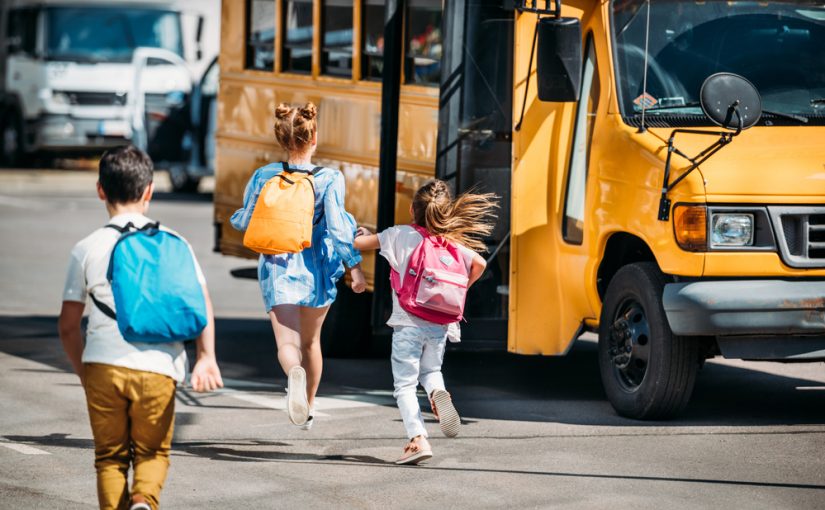Now that we’re in back-to-school season, take the time to teach your children school bus safety. Even if you’ve done it before, good habits can be forgotten over the lazy summer days so be sure to review procedures at the start of every new school year. Consumer Reports offers School Bus Safety Tips for Back to School. They suggest tips for safety while waiting for and getting on the bus, while riding the bus, and exiting the bus. It’s particularly important to give kids safety rules about remaining visible to the bus driver at all times when entering or exiting the bus or crossing in front of our behind the bus.
The American Academy of Pediatrics issued a helpful back to school safety tip sheet. We’re reprinting the safety tips that deal with traveling to and from school safely.
SCHOOL BUS SAFETY FOR KIDS
- Children should always board and exit the bus at locations that provide safe access to the bus or to the school building.
- Remind your child to wait for the bus to stop before approaching it from the curb.
- Make sure your child walks where she can see the bus driver (which means the driver will be able to see her, too).
- Remind your student to look both ways to see that no other traffic is coming before crossing the street – traffic does not always stop as required. Practice with your child how to cross the street several times prior to the first day of school.
- Teach your child to respect all the bus rules, including staying seated and listening to the driver.
- If your child’s school bus has lap/shoulder seat belts, make sure your child uses one at all times when in the bus. (If your child’s school bus does not have lap/shoulder belts, encourage the school system to buy or lease buses with lap/shoulder belts).
- Check on the school’s policy regarding food on the bus. Eating on the bus can present a problem for students with allergy and also lead to infestations of insects and vermin on the vehicles.
- If your child has a chronic condition that could result in an emergency on the bus, make sure you work with the school nurse or other school health personnel to have a bus emergency plan, if possible, prior to the first day of class.
MOTORISTS, TAKE HEED!
Train yourself to be as alert for school bus lights as you are for traffic lights. Motorists need to a complete stop when lights are flashing. Failure to do so can result in steep fines and points added to your driving record for years to come. In Massachusetts, failure to stop can result in a ticket of up to $250. That fine can go up to $2,000 and a suspended license of up to a year for subsequent offenses. In Florida, the minimum fine is $165, or $265 if you pass on the side where children enter and exit, In Connecticut, failure to stop for a school bus with flashing red warning lights can result in a hefty fine of $465 for a first offense. See state school bus laws for motorists and state motorist fines for school bus violations.
KIDS AS PEDESTRIANS OR BIKERS
If your kids are walking or riding a bike to school, they need to learn how to be safe around vehicles and traffic. Here are more tips from the American Academy of Pediatrics about walking or biking to and from school:
WALKING TO SCHOOL
- Children are generally ready to start walking to school at 9 to 11 years of age as long as they are at the right developmental skill level and show good judgment.
- Make sure your child’s walk to school is a safe route with well-trained adult crossing guards at every intersection.
- Be realistic about your child’s pedestrian skills. Because small children are impulsive and less cautious around traffic, carefully consider whether or not your child is ready to walk to school without adult supervision. If the route home requires crossing busier streets than your child can reasonably do safely, have an adult, older friend or sibling escort them home.
- If your children are young or are walking to a new school, walk with them or have another adult walk with them the first week or until you are sure they know the route and can do it safely. If your child will need to cross a street on the way to school, practice safe street crossing with them before the start of school.
- Identify other children in the neighborhood with whom your child can walk to school. In neighborhoods with higher levels of traffic, consider organizing a “walking school bus,” in which an adult accompanies a group of neighborhood children walking to school.
- Bright-colored clothing or a visibility device, like a vest or armband with reflectors, will make your child more visible to drivers.
BIKING
- Practice the bike route to school before the first day of school to make sure your child can manage it.
- Always wear a bicycle helmet, no matter how short or long the ride.
- Ride on the right, in the same direction as auto traffic and ride in bike lanes if they are present.
- Use appropriate hand signals.
- Respect traffic lights and stop signs.
- Wear bright-colored clothing to increase visibility. White or light-colored clothing and reflective gear is especially important after dark.
- Know the “rules of the road.”
Reprinted from Renaissance Alliance – no usage without permission.


